- Home
- Resources
- Choosing pencil brands
- Derwent Pencils
Derwent Pencils
Derwent pencils are marketed by an English company based in Keswick in the Lake District (The Cumberland Pencil Company) with a great reputation as being the most active in producing new quality art materials.
I will introduce each range here, and some sections will link to a dedicated page of their own.
NOTE: Derwent tend to produce pencils 8mm across and many power sharpeners cut up to 7.5mm.
- Artist and Studio
- Coloursoft
- Procolour
- Lightfast
- Chromaflow (coming soon)
Derwent Coloursoft Pencils
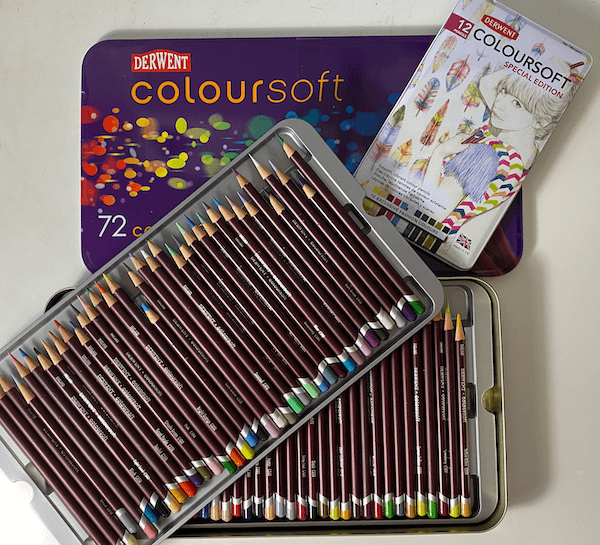
COLOURSOFT were Derwent's original answer to the American Prismacolor. A soft waxy pencil in strong bright colours in a range of 72.
The Earth colours are totally light stable but there are a few in the light shades (e.g. Pink), where you will need to be cautious over the risk of fading.
The relative softness of the core enables strong laydown of colour but there is a need to be careful as over sharpening the point will cause it to easily crumble which is wasteful.
Developing many layers, even on hot pressed paper, is simple, and burnishing the top layers will result in a smooth, well-colored image.
Whilst these Derwent pencils handle well, the 8mm round barrel does not fit in all power sharpeners and that can be inconvenient.
A good pencil - particularly now the wax pencil colour range has been augmented by the Procolours.
Coloursoft pencils can be purchase individually at £2.39 direct from Derwent, whereas the sets of 72 will set you back £172.49.
You can download the Derwent Coloursoft colour chart here.
Derwent PROCOLOUR pencils
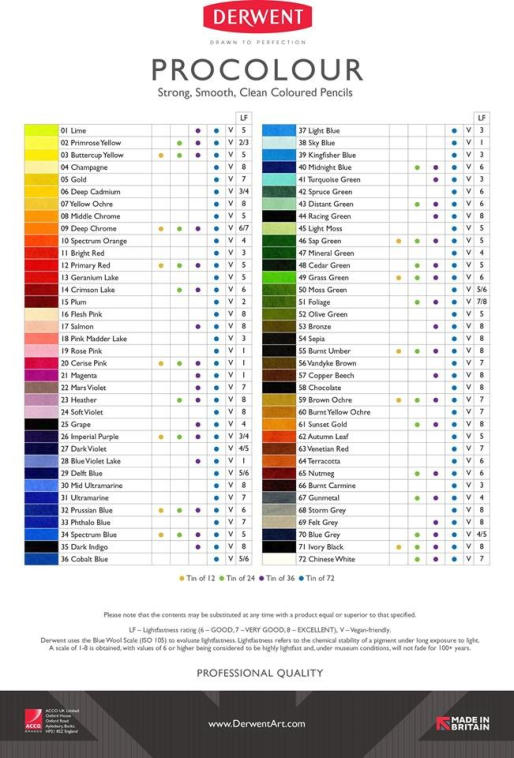
This line of wax based coloured pencils were launched in the UK in mid July 2017. They have a handling feel with softness somewhere between the harder Artist range and the softer Coloursoft.
The Procolour pencils will take a very fine point in a power sharpener and there is little or no sign of crumbling from the needle sharp tip when used.
The colour range in the 72 Procolour pencils is slightly different from Coloursoft so a combination of the two lines will give over a hundred unique colours.
Procolour are not quite as vibrant, so a completed all Procolour artwork will be recognisable by the more subdued but possibly more detailed finish against Coloursoft.
I think it fair to say that these fit into a logical slot as a softer version of the Artists/Studio pencil.
In January 2024 the price listed on the Derwent site for these pencils shows from £2 each.
There are many YouTube reviews of this line that I recommend you view to get a good cross section of views. In my own view they are a good pencil, subject to the comment below on lightfastness ratings.
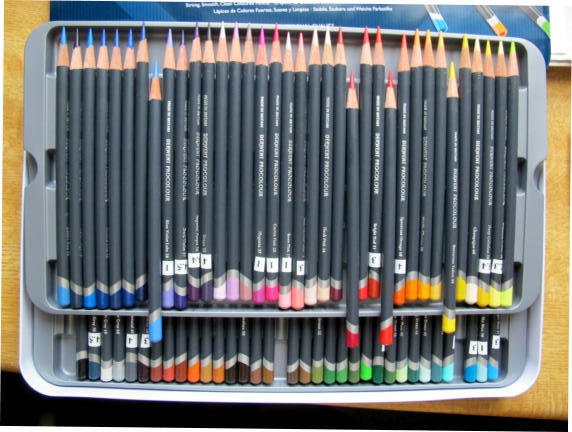
One issue raised by many artists commenting on this recent line of Derwent pencils, is the lack of lightfastness for so many colours.
For a new pencil line promoted for professional artists, I think that it is a shame that the opportunity was not taken to follow the example of other manufacturers and go for higher lightfast levels. I suggest that anyone using these seriously would be advised to mark the lower LF numbers on the pencils with clear labeling as I have done in the photo above.
The alternative, if you have a full set of Coloursoft, is to remove the few low lightfast colours from the Coloursoft set and amalgamate all the good lightfast colours (118 at my count) to make one excellent set.
Yes, you will lose some pale colours, but nothing that you can’t deal with using a layer of white or a bit of judicious blending. It is easy to see which are the softer and harder pencils from the colour of the barrel.
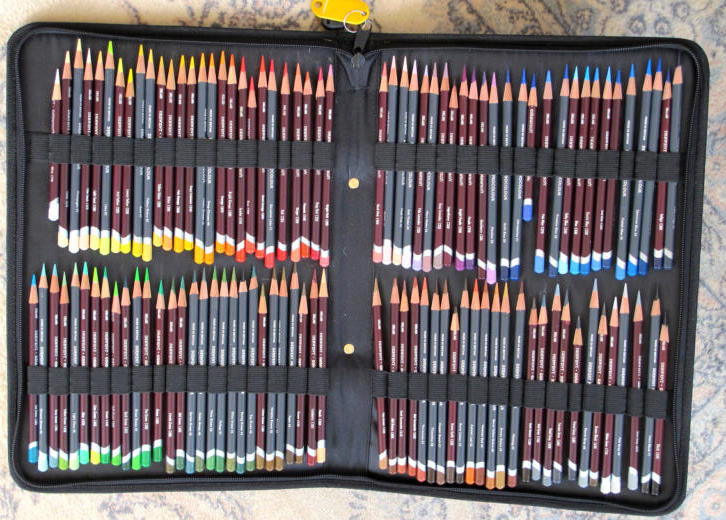
The photo above shows an amalgamated set of Derwent pencils. All these colours are rated LF Blue Wool Scale 4 or above.
Derwent Lightfast Pencils
A recent collection of pencils with a higher percentage of oil than wax. This is unusual for Derwent as they have for years concentrated on pencils with a wax based core.
The set was released in June 2018 in time for the Patchings Festival at Nottingham and presented an initial 36 colours all tested at ASTMS LF1, the highest lightfastness level. Further colours were introduced as the testing of the extended range was completed, bringing the total to 100. The price range as at January 2024 is around £3.30 per pencil, or £99 for a set of 36 or £287 for a tin of 72, taking them among the more expensive ranges.
For many artists, myself included, they are fast becoming a useful addition to my collection. Due to my impatience I purchased the first two sets of 36 as they became available and then the rest as open stock. The full 100 range is now available in a tin at £398, and a wooden box set for £460.
These Derwent pencils are softer than the Artist and Studio range and have a very different feel from the Coloursoft. They have a smooth lay down of highly pigmented colour which easily blends on the page with little pressure needed.
Lightfast coloured pencils have been a holy grail that artists in coloured pencil have wanted for a long time.
Caran d’Ache brought out the Luminance range a few years ago and these were the best attempt so far at a pencil to meet the American ASTMS 6901 standard. Previous attempts by Prismacolor were dropped as unprofitable and the old Derwent Signature departed many years ago as they were too dry and scratchy (the combination of pigment and binder at that time was not at all good).
Ivor Harrison has a detailed review in the Art Gear Guide online where he compares Luminance and Lightfast in his studio conditions.
Derwent Watercolour pencils
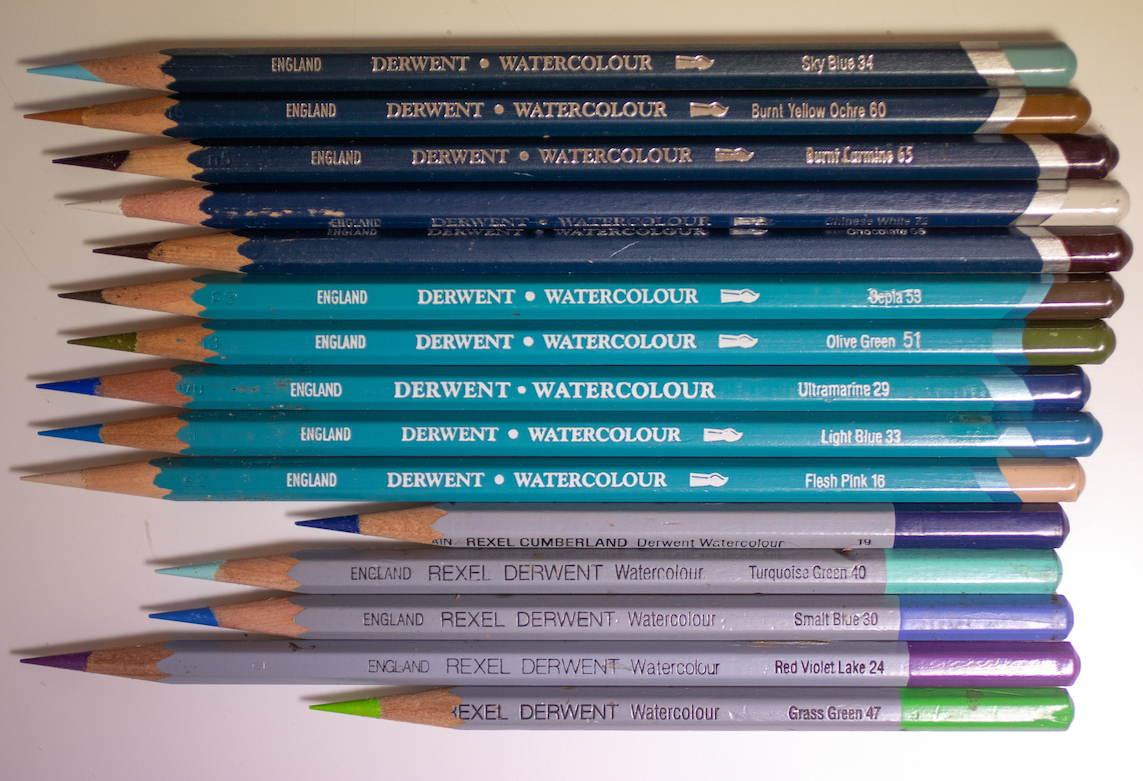 Derwent Watercolour pencils through the ages
Derwent Watercolour pencils through the agesDerwent Watercolour pencils have been in production for many years and were last reformulated and replaced in 2009.
The old design had Turquoise coloured wood and came in 72 colours. The more up to date design has a dark blue hexagonal barrel.
If you come across any with grey barrels, these are a very old range and you will find them poor compared to the latest version. You'll notice that one of mine in the photo above mentions Cumberland, which could be called ancient.
Some of the colours in the original line had very low lightfastness ratings. I liked the old turquoise barrelled pencils which were medium hardness and handle well.
The new line still has 72 colours (some new), a softer core and higher lightfastness levels. There are still some poor ratings in some colours.
The colour range is good for landscapes with a good selection of greens and browns.
Peter used the current formula pencils for a step by step picture of Venice. This was done on cold pressed watercolour paper and the result was acceptable bearing in mind the surface.
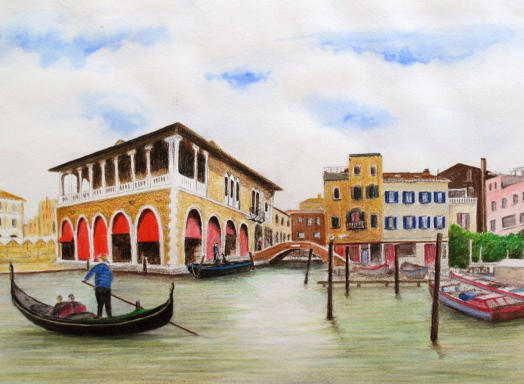
Some of their colours may not be suitable for creating broad, sweeping washes for backgrounds. The reason? The pigment might not be as finely milled as in other brands.
But don't let this minor hitch deter you! This issue typically comes up only when you're heavily diluting the colours. Even then, it's not a common problem. When you're using these pencils in their dry form, and then adding water to your paper, you're more than likely to be just fine.
One thing to keep in mind
An artist who took the watercolour pencils to Tunisia, with temperatures of 30 degrees, found that they were inclined to soften and break easily. This could be a problem with many of the softer brands. Therefore, you might like to consider keeping the pencils in a coolbag in hot weather to reduce this issue.
Grab a bargain!
If you wish to try Aquarelles (water soluble pencils) and notice sets of the old watercolour pencils with turquoise coloured barrels on sale at a great price, take advantage of the offer. You may see deals like ‘half original price’ and the old pencils are good, even if they are a little harder to the touch than the new ones. You may even get a fancy wooden box with them.
They may even work well in Tunisia!
Inktense Water Soluble Range
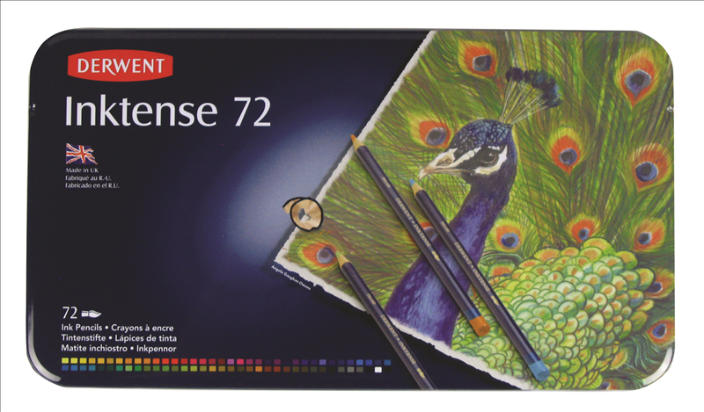
Learn more about these pencils on my dedicated page.
Inktense pencils have been one of Derwent’s more successful innovations. As of December 2024 there are 100 colours available.
These are water soluble pencils which erase as a dry medium, but once water is applied they are permanent on the paper.
Don’t confuse permanence with lightfastness, there are still a number of lower rated pigments here, though not too many.
They are a good option if you work with bright or strong colours. A number of professional artists like them for underpainting the paper before adding dry colour. It speeds up the painting process a great deal. There is quite a major step up in colour strength when wet, and you need to know what the effect of water is going to be before you set out on a picture.
I suggest you do your own chart showing the colours both in their dry state and also after wetting. The darker colours come up very strong and only show differences when well diluted. I strongly advise that the first time you use them, you test the pencils and paper out first, and keep your pigment strength low on the paper until you are used to them. They probably have the highest colour strength of any aquarelle pencils.
With practice you will learn how much water to add, to get softer colours.
You can download the Derwent Inktense colour chart here.
In 2011 Derwent introduced a further new product in the Inktense group - Inktense Blocks. These are hard, pastel like sticks with a flat overall shape designed to be used as either a drawing tool (like pastel) or as a source for wet pigment. There are 24 colours available in sets of either 12 or 24. Pigment and handling are said to be the same as the Inktense pencils.
More recently Derwent also released the Inktense Paint Pan Studio set, containing 24 colours.
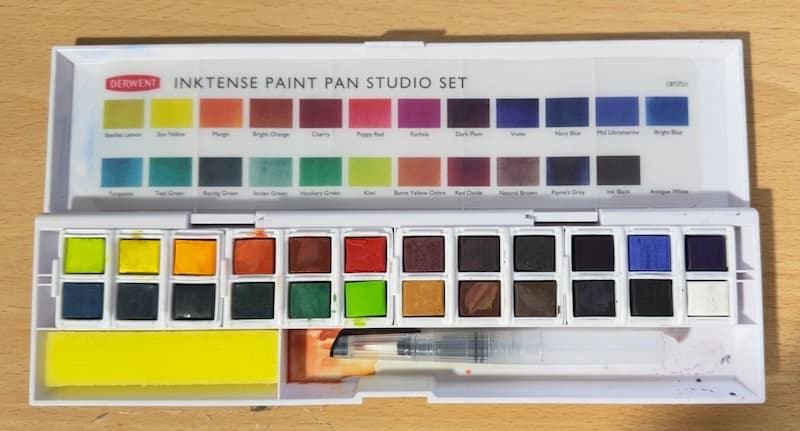 My slightly messy Studio Pan set
My slightly messy Studio Pan setDerwent Artbars
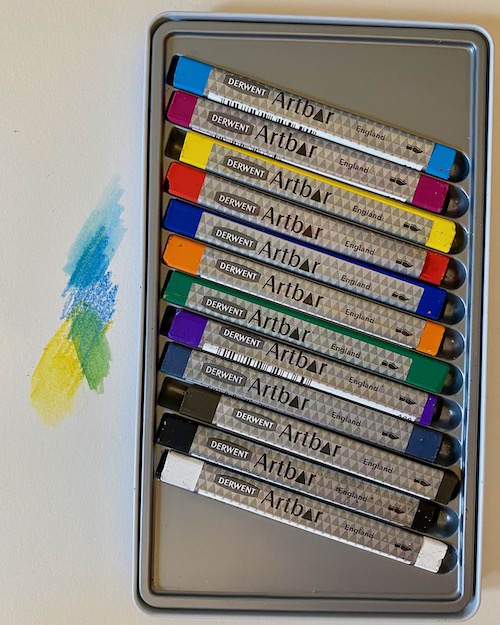
Although not Derwent pencils this line was introduced early in 2012. They are triangular shaped soft wax crayons containing a soluble medium and strong pigment content.
I have seen these used for the background in colored pencil drawings, and they would certainly speed up the process. As the colours can be easily blended with water I felt a small set was sufficient. They appear to be more a craft than a fine art product. There are some interesting accessories (this seems to be the current trend - to introduce a product and sell a number of associated tools and pieces of equipment).
Derwent Drawing Pencils

This small range of 24 natural colours are all totally light stable. These wax based Derwent pencils have a soft, creamy texture and are ideal for working over the top of harder pencils, such as the Artist range. They come in tins of 12 (£31) or 24 (£43) - prices correct as of January 2024.
A long standing range in the company's collection, with some good colours for portraits and animal studies. I find them ideal for animal whiskers over the top of a drawing done in other coloured pencils.
The Chinese White pencil is one of my favourites, being buttery and opaque.
Graphitint Pencils

These are a water soluble coloured graphite pencil,
There is a range of 24 colours. When dry colour is applied they are all shades of grey. The colour only really comes out when water is applied.
The original formula was very low on fade resistance in half of the colours and the range was therefore not recommended, but an upgrade has resulted in only 4 of the colours now having a low blue wool scale rating.
Very soluble and an interesting collection of shadow colours which will appeal to those looking for a different approach to colour. If Graphite ‘rocks your boat’ these pencils could be worth trying.
You can download the Derwent Graphitint colour chart here.
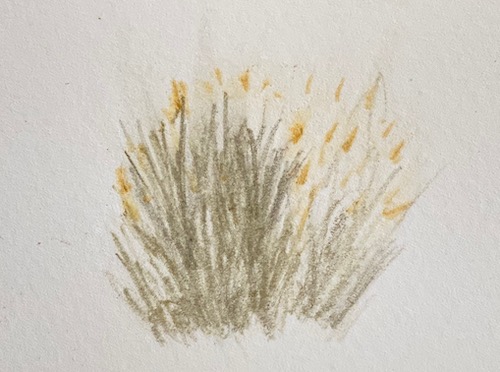
Metallic pencils
An interesting line of 20 reflective colours, the Metallic pencils work excellently on dark papers. Best used alone - they do not need white underneath on black paper.
Environmentally friendly products
All the new lines from Derwent are manufactured in a state-of-the-art factory which operates to top environmental standards.
The paint used to colour the wood of the pencils is environmentally sound and uses no solvents. This does mean, however, that some colour may be expected to leach from the barrel of the pencil on to your hand when used on a hot day.
Derwent seem to be standardising on sets of 72 colours which will enable them to market pencils in standard sized tins and boxes. For the serious artist, this may reduce the colour choice if the older lines are totally withdrawn, as the main competitors are selling sets up to 120 colours in the range.
Derwent pencils original Artists range
These Derwent pencils are most suitable for application on a hard surface paper like cartridge or a smooth (HP) watercolour paper. The formula enables a very fine point to be produced which aids getting the fine detail loved by Botanical artists.
There are a good selection of greens and landscape colours and some unique shades in these pencils. They used to be available in 120 colours but now you can't buy tins containing more than 72 pencils.
The pencils in both these and the Studio's (below) were designed many years ago and there are a larger than average number with low lightfastness (LF). They are good pencils, though, and a lot of professional artists still rely on them. You do need to use a fair bit of pressure to get the pigment onto the paper.
You can download our Derwent Artists colour chart here.
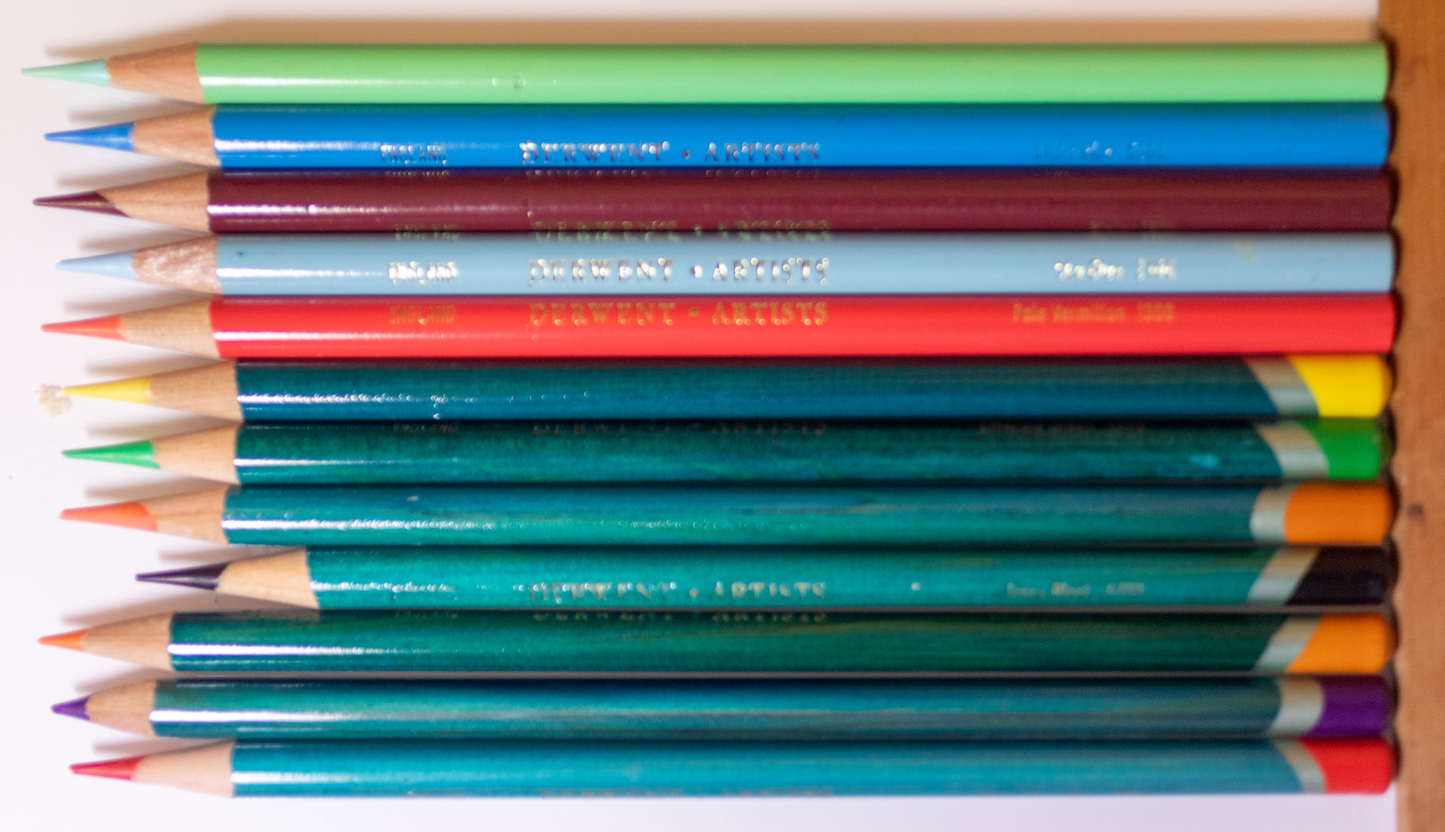 Derwent Artist''s pencils with 2 different liveries
Derwent Artist''s pencils with 2 different liveriesDerwent Studio pencils for detailed work
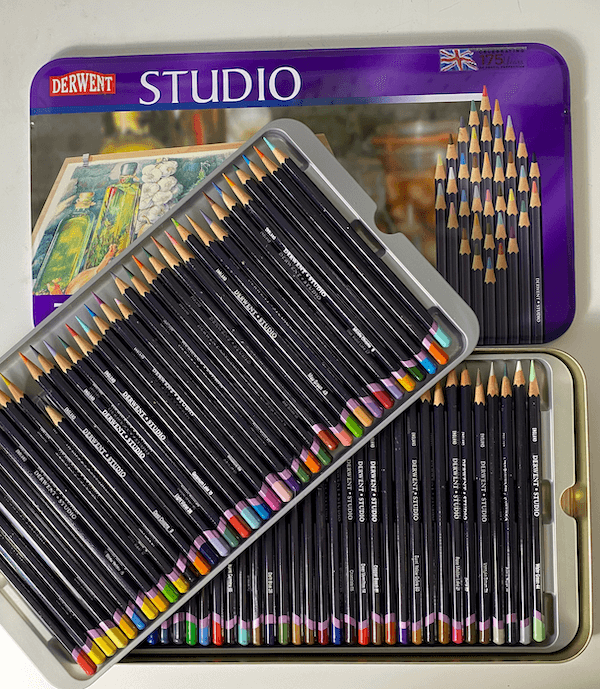
Sadly the Derwent Studio pencils were discontinued in 2023, although some stock was still available as of December 2024. As they were a mainstay of the Derwent range I am keeping this section on the page, but have moved it from the top down to the bottom.
The only differences between the cores of these Derwent pencils and the Artists range, is that they are thinner in the Studios.
Most colours match across the two lines, the only difference being that ARTIST is sold in 120 colours, round barrelled with a 4mm core, and STUDIO is sold in 72 colours, Hexagonal barrel, and 3.4mm core.
Individual Studio pencils are currently for sale (January 2024) at £2.50 each direct from Derwent.
Accessories to consider
Derwent also make a Blender pencil and a Burnisher pencil - sold in a pack with two of each, an eraser and a small sharpener for around £5.50. The burnisher can also be used as a resist for keeping pale lines reserved. (see the burnishing page).
Among accessories marketed by this company, are a battery eraser, various sharpeners, pencil extenders and tools for manipulating the colour on the paper.
Improve Your Pencil Art: Get Free Tips & Techniques
Sign up for our newsletter – just occasional emails packed with practical advice and inspiration for pencil artists like yourself












